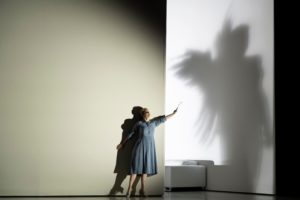
Glyndebourne Festival 2021 Review: Kat’a Kabanova
Kateřina Kněžíková Towers Over an Intimate, Searing Vision of One of Opera’s Most Complex Selves
By Benjamin PooreIt is an under-appreciated coincidence that Janacek’s searing opera of bourgeois repressiveness and psychological collapse appears in the same year as fellow Moravian Sigmund Freud’s “Beyond the Pleasure Principle” and his study of “Mass Psychology” (they were, in fact, born mere miles apart). “Kat’a Kabanova” is a psychic drama of shame and self-hatred.
As in Freud’s work, Janacek creates a space for an incredibly rich examination of the internal dynamics of the self, especially the dark forces that drive us – and push us apart. The conductor Mark Wigglesworth once described the score as “unindulgent but totally passionate.” It is a humane drama – full of rage and empathy – but unsparing in showing the hypocrisies and miniature cruelties of dysfunctional family life.
Kat’a Kabanova opened the Glyndebourne festival this year in a new production from Damiano Michieletto, a director who has shown his gift for depicting the viciousness of small town life in a regularly revived pairing of “Cavalleria Rusticana” and “Pagliacci” up the railway line at Covent Garden. The weather was, predictably, unseasonably gloomy but thematically appropriate for an opera based on Alexander Ostrovsky’s “The Storm.”
The Symbolic & Psychological
Michieletto’s production is symbolic and psychological first and foremost. The white set designs by Paolo Fantin suggest an abstract dream space – there is no village or river, only the interior of Kat’a’s mind. Their acute angles are redolent of the kinds of vitrine-like structures that so fascinated Francis Bacon in his paintings; these walls close in on Kat’a at the end of Act one, trapping her in the room with Kabanicha, which then ingeniously segues uninterrupted into the beginning of Act two.
The stage is populated by the raw symbols of the text, as if taken from the psychoanalytically minded paintings of Dali, Magritte, or de Chirico. A rock stands in for her feelings of imprisonment; it also resembles an egg, which evokes the ossified half-life Kat’a lives under Kabanicha’s cruel domestic regimen. Feathers fall from the fly tower at one point. The angels of Kat’a Act one vision are visualised in a group of white-trousered topless dancers, their winged leader danced by Robin Gladwin. Bird cages hang over the stage in Act three; they crash to the floor, in a stunning coup de théâtre, at the moment of Kat’a suicide. Much of the action orbits, rather tellingly, around a couch. There is some crudeness to these symbolic gestures, and the dancing at times is overbearing, but the overall mood is well established.
This spare approach yields much in intensifying our feeling for the psychological complexity of Janacek’s central character. Thoughtful lighting from Alessandro Carletti plays with brightness and shadow in ambiguous, beguiling ways in an opera where visions of purity and transcendence are only a whisker away from death and oblivion. This is a threshold that Kat’a wanders across and almost seems to yearn for. The radiant white of the opening may be a vision of heaven but it is also a void or abyss, sterile and inorganic. Her dreams of salvation may be nothing more than an extravagantly re-routed version of the Freudian death drive. She ends Act one draped in a black veil by Tichon and Kabanicha.
Astonishing Central Figure
It’s bleak and powerful stuff, intensified by an astonishing central performance from Kateřina Kněžíková. As a native Czech-speaker she has a considerable advantage when it comes to realizing Janacek’s unique approach to word-setting, which gets its emotional and psychological charge from his open-hearted musical setting but also retains the simplicity and directness of everyday speech. Kněžíková has enough power and lyricism to open up the former to its most searing extent, but a naturalness in delivery of the latter. She especially excelled in the climactic scene of Act three, to which we had been building since her gorgeous religious vision of Act one.
The counterweight to her tenderness and fragility was Katarina Dalayman’s Kabanicha, who sings and dresses with cold glamour; as a representative of a malevolent maternal superego, she moves starkly around the stage with a kind of clipped brutality. At the climax of the show she glibly thanked those onstage, with half an implicatory eye at the audience, for their help, and briskly strode off.
Smaller roles were not given short shrift. Nicky Spence sang aggressively as the weak, alcoholic Tichon, letting the brutality and anger that come from his dysfunctional family dynamic burst through in the voice. David Butt Philip’s Boris was darker and more lyrical in hue, a tender opportunity for Kat’a that was never to be. Varvara and Vána – Aigul Akhmetshina and Thomas Atkins respectively – made a light, but tragic contrast to the misery of Tichon and Kat’a.
Robin Ticciati conducted the London Philharmonic Orchestra in a reduced orchestration of the score. Some of the oceanic feeling of Janacek’s orchestral climaxes are lost with smaller forces, but we also gain in transparency and intimacy. The opera’s very opening had an intense privacy, mere solo lower strings, that redoubled our sense of this as a deep psychological dive into the secret places of the self (This is a composer who wrote a string quartet called “Intimate Letters,” after all).
The smaller string and brass forces also allowed Janacek’s piquant, recursive woodwind melodies a special spotlight and an intensely lonely quality. Because of COVID-19 none of the cast members are allowed to touch – a circumstance of the times, but a fortuitous artistic opportunity in an opera that describes isolation and shame with such expressive force.
All told, this is bracing and urgent musical storytelling that has launched the Glyndebourne festival with passion and purpose.


